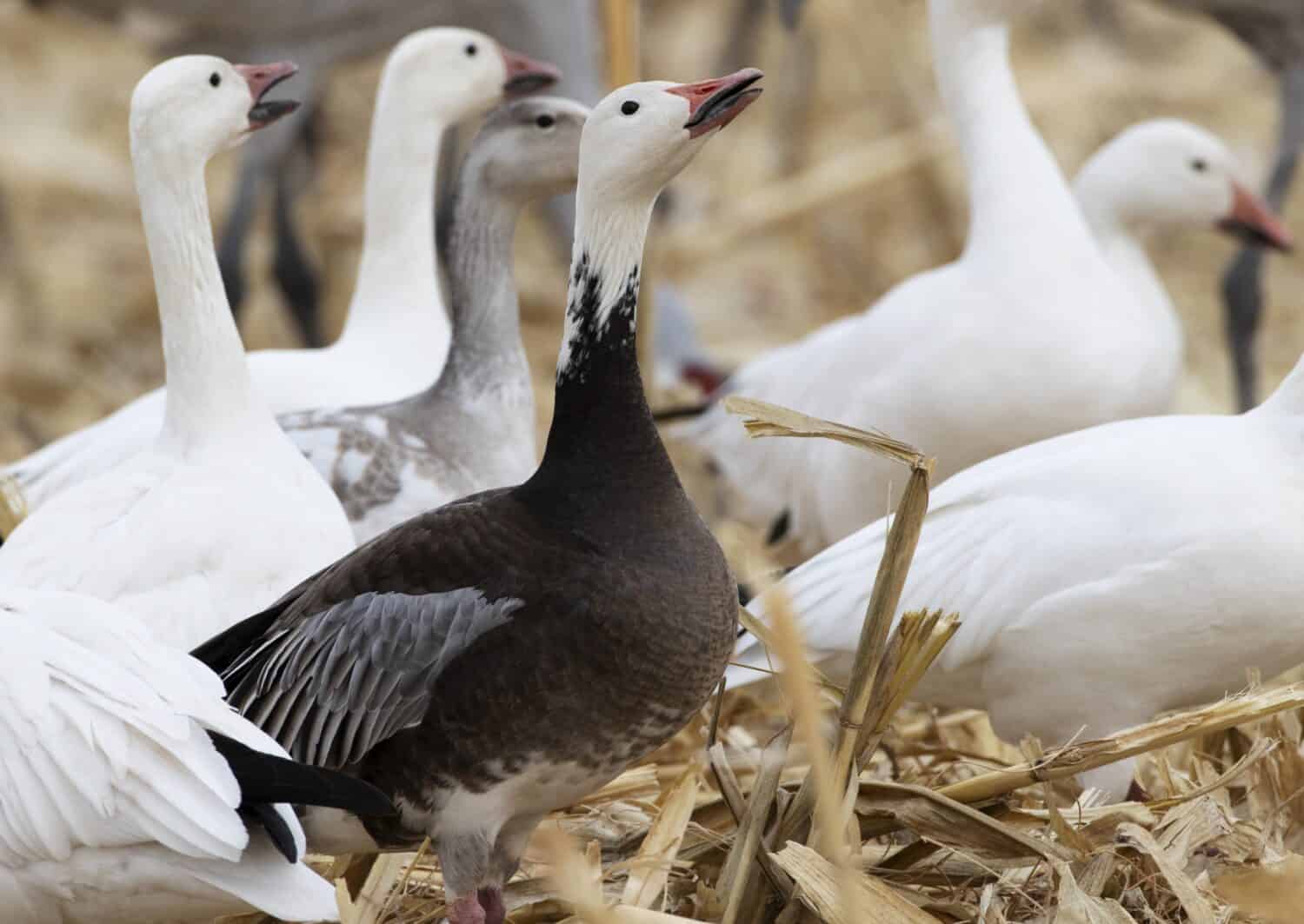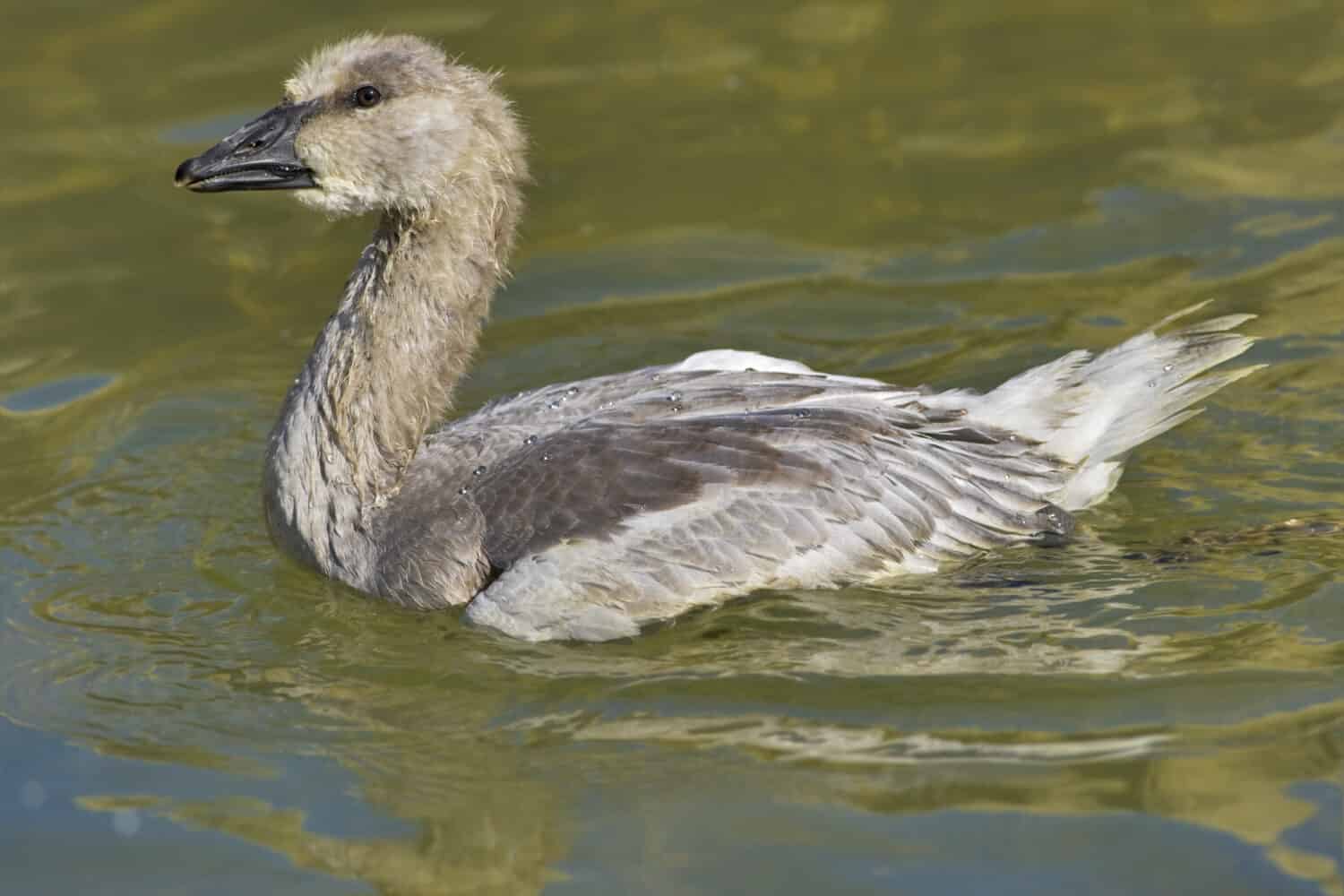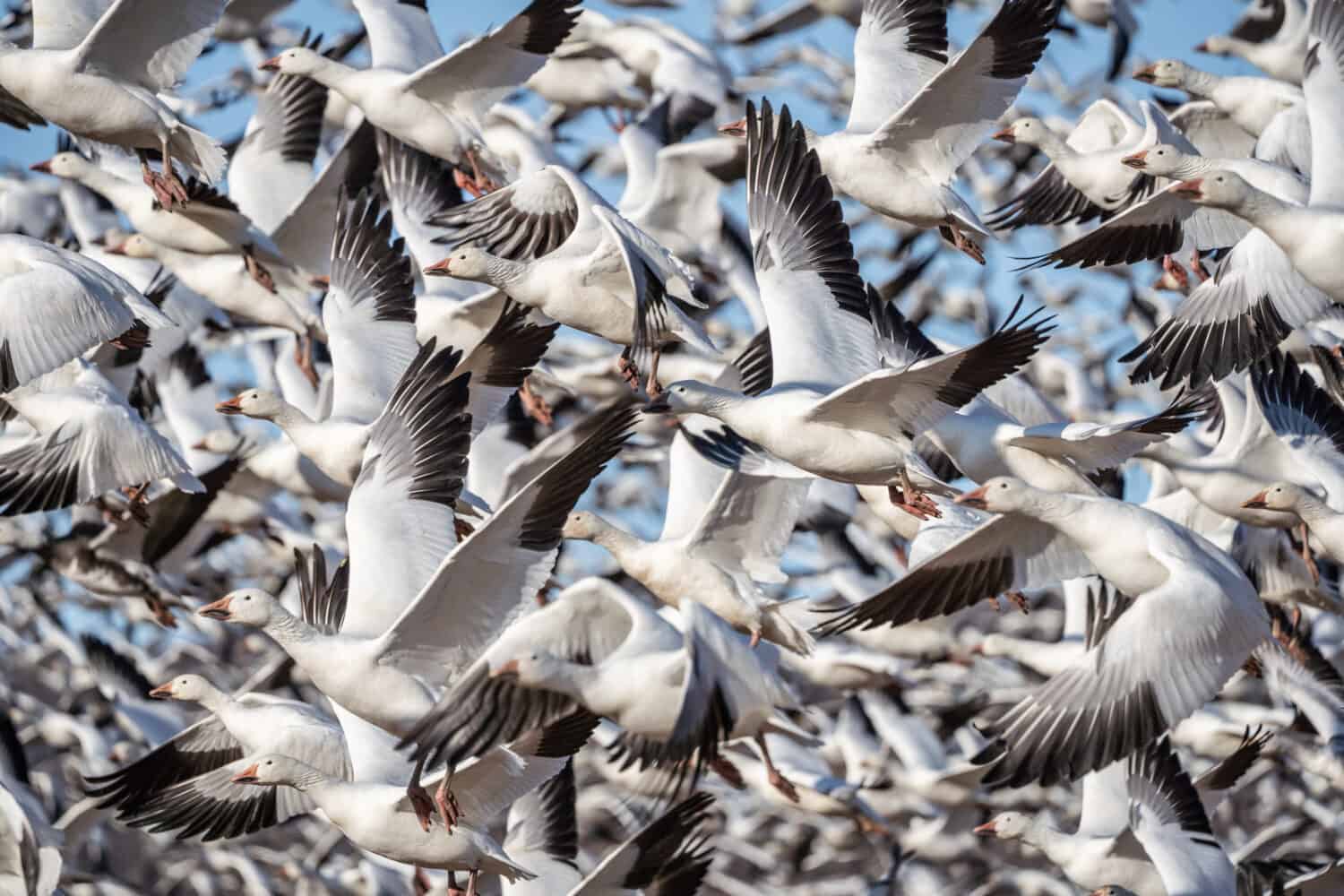Snow Goose
Anser caerulescens
The snow goose has a dark line along their beaks known as a ‘grinning patch’!
Advertisement
Snow Goose Scientific Classification
- Kingdom
- Animalia
- Phylum
- Chordata
- Class
- Aves
- Order
- Anseriformes
- Family
- Anatidae
- Genus
- Anser
- Scientific Name
- Anser caerulescens
Read our Complete Guide to Classification of Animals.
Snow Goose Conservation Status
Snow Goose Facts
- Name Of Young
- Gosling
- Group Behavior
- Flock
- Fun Fact
- The snow goose has a dark line along their beaks known as a ‘grinning patch’!
- Estimated Population Size
- 16 million
- Wingspan
- 54.3 inches
- Incubation Period
- 24 days
- Habitat
- Lakes, rivers, ponds, open fields and pastures, and coastal shores.
- Diet
- Herbivore
- Lifestyle
- Flock
- Special Features
- Black "grinning patch"
- Average Clutch Size
- -1
- Nesting Location
- On dry land near coastal water
- Migratory
- 1
View all of the Snow Goose images!
Snow Goose Summary
“The snow goose has a dark line along their beaks known as a ‘grinning patch’!”
Snow geese are an average-size species that comes in two different morphs or colors. They are found throughout much of North America. They are rarely seen traveling without the presence of a large flock around them. Their population is thriving, a fact which many researchers contribute to their use of agricultural fields.
Snow Goose Amazing Facts
- There is a blue morph and a white morph, with the white gene being recessive to the dark.
- Within their first three weeks of life, this species may walk up to 50 miles.
- The oldest individual was over 30 years old.
- They mate for life.
Where to Find Snow Geese
The snow goose is a North American species and can be found from southern Mexico to the Queen Elizabeth Islands (the northernmost islands in the Canadian Arctic Archipelago), depending on the time of year. Despite this, certain varieties may choose to settle on nearby continents. This includes those that winter in the western regions of North America, occasionally breeding in Siberia, or those in the east breeding in Greenland.
Most often, you will see them in migration, as this is when they are settled in the largest range of areas. During migration, they can be seen in the southernmost regions of the United States all the way to the northern coast of Alaska and continental Canada. The majority of the species breeds in the Queen Elizabeth Islands, where there are few human inhabitants to enjoy the sight of these geese and their goslings. Come winter, many will settle in the United States, with large populations dotting the eastern and western coasts as well as being largely abundant in the central region of the country. Some may also winter in central and coastal Mexico.
Snow geese will typically nest along streams and ponds, though they may also choose to settle around coastal salt marshes and brackish marshes. Alongside these aquatic environments, snow geese have also taken to agricultural fields and other open habitats for the winter.

Snow geese can be found as far north as the Queen Elizabeth Islands.
©Feng Yu/Shutterstock.com
Snow Goose Nests
The female is responsible for choosing the nesting site, although the male will be alongside her for the process. This spot is often hidden by vegetation. When possible, snow geese prefer to build their nest on dry ground. Because they breed in arctic regions, however, this can be difficult, as the melting snow often leaves the ground damp. Sometimes, she will begin several nests before choosing a permanent one. After this, she may begin to lay her first egg within one hour.
Along with picking the nesting location by herself, the female builds the nest on her own. As he develops the nest, she lays eggs. Typically, the nest begins as a small scrape in the ground to which she adds down feathers plucked from her own plumage. In areas where there is less vegetation courage and thus less security, the larger and more well-developed the nest will be. Some may include natural materials, such as grasses, twigs, and seaweed.
Snow Goose Scientific Name
The scientific name of the snow goose is Anser caerulescens. This name originates from Latin, from the words anser, meaning ‘goose,’ and caerulescens, meaning ‘bluish,’ as derived from the word caeruleus, meaning ‘dark blue.’
They are in the class Aves and the order Anseriformes. Their family is that of Anatidae, which contains ducks, geese, and swans.
Snow Goose Size, Appearance, and Behavior
The snow goose is a rather large bird, although it is around average size for a goose. They are compact, however, with smaller necks than other species, such as the Canada goose. Adults can grow to be 27.2 to 32.7 inches in length, and they can weigh 56.4 to 116.4 ounces. They have a large wingspan, with that of an adult individual averaging around 54.3 inches from wingtip to wingtip.
There are two different morphs for this species. The first is the recessive morph, which is entirely white with black wingtips. These black markings may not be easy to see on the ground, but they are visible during flight. The second morph is the dominant dark morph. Geese with this morph have dark brown bodies with white heads. The underside of their tail is also white.
Regardless of the morph, these geese have pink bills with a black marking known as a grinning patch.
This differs for juveniles, however. Juvenile white morph geese are speckled with areas of brown buff, especially on their head. Juvenile dark morphs are dark brown all over, with no noticeable white markings on their plumage. They also tend to have darker bills, though the grinning patch is still visible in many individuals.
Snow geese travel together in large flocks. Usually, this includes a few dozen other individuals of the same species. However, it can also include up to several thousand individuals.

There are two different morphs of snow geese.
©Florence-Joseph McGinn/Shutterstock.com
Snow Goose Migration Pattern and Timing
Snow geese are medium-distance migrants with no notable year-round populations. They winter in the southernmost extents of their range, in the United States and Mexico, before migrating through the countries to settle in the northern region of Canada for breeding.
Snow Goose Diet
The snow goose is primarily an herbivore, although goslings may consume some animal products. They easily consume the entirety of the plant through a variety of methods, including grazing as well as ripping the plant through the ground.
What Do Snow Geese Eat?
Some of the plants that snow geese will eat include:
- Stems
- Leaves
- Tubers
- Roots
- Seeds
- Fruits
- Flowers
Young goslings may occasionally eat fly larvae.
Snow Goose Predators and Threats
Overall, snow geese face few significant threats outside of predation from both other animals as well as humans. This is because they typically nest in remote areas with little to no interference. However, like all species of waterfowl, they can be threatened by pollution in the waterways in which they live. Because they forage on the ground, they may also occasionally suffer from lead poisoning as a result of consuming dropped lead shots.
What Eats Snow Geese?
Some of the predators for these geese and their young include:
- Gulls
- Foxes
- Jaegers
- Caribou
- Polar bears
- Black bears
- Gray wolves
- Ravens
- Owls
- Eagles
Snow Goose Reproduction, Babies, and Lifespan
Snow geese mate for life. They will often choose their mate based on morph, preferring mates with the same plumage as close family members. The female incubates the nest while the male stands guard, though he may occasionally leave for short periods of time.
This species has one brood per year, usually containing, on average, two to six eggs. These eggs are white in color and can be easily stained. This helps in identifying the oldest eggs, as they will often possess more stains than those laid more recently.
The average incubation period for this species of goose is 24 days. During this time, the female can spend over 21 hours each day in the nest. When they are first born, the young goslings are covered in down with their eyes opened. The nestling period lasts only a day before they are able to leave the nest.

Young goslings are born with down and are able to leave the nest after one day.
©Tathoms/Shutterstock.com
Snow Goose Population
The snow goose is a species of least concern. In fact, they have actually experienced impressive population growth in recent decades. Many scientists have attributed this to the fact that the arctic regions of the snow goose’s range are warming. This includes areas where snow geese migrate and breed, creating more inhabitable conditions for these birds. They are estimated to have a global breeding population of 16 million individuals.

These geese can form flocks featuring several thousand individuals.
©Amy Lutz/Shutterstock.com
Snow Goose FAQs (Frequently Asked Questions)
Do snow geese migrate?
Yes, for both breeding and wintering.
How many eggs do snow geese lay?
Snow geese can lay between two and six eggs per year.
How fast do snow geese fly?
Snow geese can reach speeds up to 50 miles per hour.
What is the snow geese's wingspan?
They have a wingspan of 54.3 inches.
When do snow geese leave the nest?
They are born with down and eye open, and they are able to leave the nest after one day.
Thank you for reading! Have some feedback for us? Contact the AZ Animals editorial team.
Sources
- , Available here: https://link.springer.com/article/10.1007/s13280-016-0887-1

















